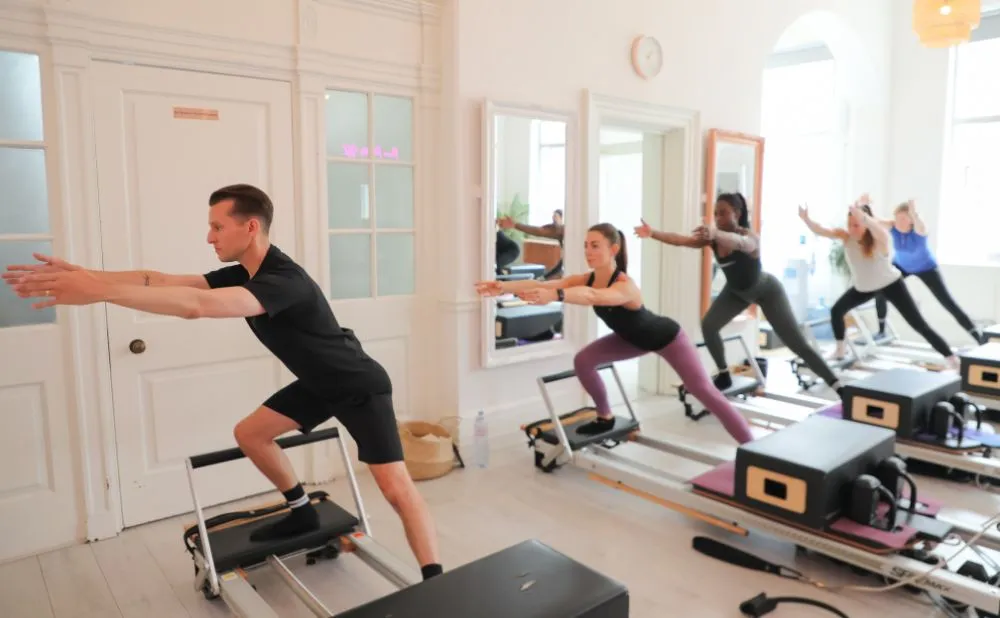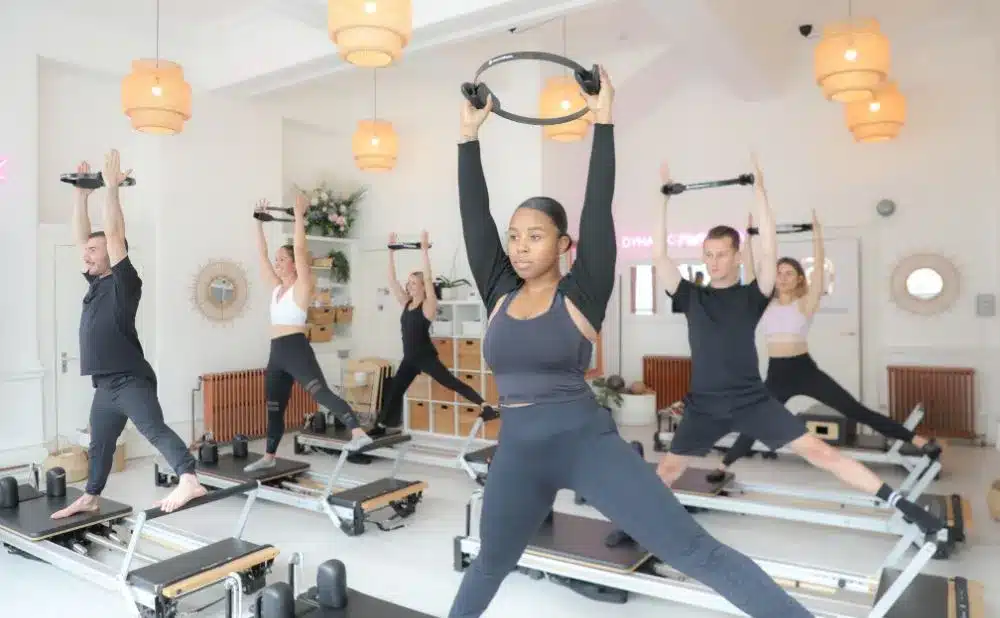Pilates has long been celebrated as a holistic and effective exercise method that promotes strength, flexibility, and body awareness. While the most popular practice of Pilates often involves mat-based exercises, incorporating specialized equipment and props can add an exciting dimension to your workouts. Dynamic Pilates classes, in particular, have gained popularity for their fast-paced, energetic nature that challenges the body in new ways. In this blog, we will explore the various Pilates equipment, props, and additional elements such as weights, used in dynamic Pilates classes, and understand how they are an added challenge and benefit to achieve a stronger, more flexible, and balanced body.
1. Pilates Reformer
The Pilates Reformer is a cornerstone piece of equipment in dynamic Pilates classes. With its moving carriage, springs, ropes, and straps, the Reformer offers a versatile and challenging workout that targets multiple muscle groups simultaneously. The Reformer’s functions in dynamic Pilates classes include:
Full-Body Strength Training: The varying levels of resistance provided by the springs allow for effective strength training of both large and small muscle groups. Dynamic Pilates classes often incorporate dynamic movements based on the ‘isolate, fatigue stretch’ principle on the Reformer to promote muscle endurance and tone.
Core Engagement: Throughout Reformer exercises, maintaining stability and control over the moving carriage requires constant engagement of the core muscles, leading to improved core strength and stability.
Enhanced Flexibility: The dynamic movements on the Reformer involve lengthening and stretching muscles, contributing to improved flexibility and range of motion.

2. Pilates Cadillac/Trapeze Table:
The Pilates Cadillac, also known as the Trapeze Table, is another valuable piece of equipment found in dynamic Pilates classes. With its bars, straps, and springs, the Cadillac offers an array of exercises that challenge the body in various planes of movement. Its functions in dynamic Pilates classes include:
Spinal Mobility and Decompression: The Cadillac allows for movements that gently decompress the spine, alleviating tension and promoting better spinal mobility.
Whole-Body Conditioning: The Cadillac offers a comprehensive workout that targets the upper body, core, and lower body, providing a well-rounded training session.
Flexibility and Stretching: Using the Cadillac’s straps and bars, dynamic Pilates classes can incorporate dynamic stretches that enhance flexibility and help prevent muscle imbalances.
3. Pilates Chair:
The Pilates Chair, also known as the Wunda Chair, is a compact and versatile piece of equipment used extensively in dynamic Pilates classes. Its compact design makes it ideal for functional exercises that challenge stability and strength. The functions of the Pilates Chair in dynamic Pilates classes include:
Lower Body Strength: The Chair’s unique design allows for targeted lower body exercises that challenge the legs, glutes, and hips, promoting strength and tone.
Balance and Stability: Dynamic Pilates classes often incorporate movements on the Chair that require balance and stability, engaging the core and small stabilizing muscles.
Proprioceptive Training: The Chair’s movements challenge the body’s proprioception, which is the sense of position and movement of the body in space. This improves body awareness and coordination.
4. Pilates Barrel:
The Pilates Barrel, available in various shapes and sizes, is a valuable prop used in dynamic Pilates classes to enhance stretching and strengthening exercises. The functions of the Pilates Barrel in dynamic Pilates classes include:
Spinal Flexibility: The curved shape of the Barrel allows for gentle backbends and stretches that promote spinal flexibility and mobility.
Chest Opening and Posture Improvement: Dynamic Pilates classes use the Barrel to perform exercises that open and stretch the chest muscles, counteracting the effects of hunching over during daily activities.
Core and Hip Flexor Strengthening: Many Barrel exercises target the core and hip flexor muscles, promoting strength and stability in these areas.
5. Magic Circle
In dynamic Pilates classes, the Magic Circle is often incorporated into arm and leg exercises to target the upper and lower body muscles effectively. Here are some key functions of the Pilates
Targeted Upper Body Strengthening: Using the Magic Circle in arm exercises like bicep curls or shoulder presses engages the muscles of the arms, shoulders, and upper back, enhancing the strength-building benefits of the workout.
Effective Lower Body Activation: Placing the Magic Circle between the thighs during leg exercises, such as leg lifts or bridges, adds resistance to the inner thigh muscles (adductors) and challenges the core for stability.
Promoting Better Body Awareness: As the practitioner squeezes the Magic Circle, they become more mindful of their muscle engagement and focus on maintaining proper form throughout the movements.
Enhancing Flexibility and Range of Motion: The Magic Circle can be used for stretching exercises, such as placing it around the feet during seated stretches or forward bends, to intensify the stretch and encourage greater flexibility in the muscles.
Adding Fun and Creativity: Dynamic Pilates classes benefit from the Magic Circle’s versatility, adding an element of fun and creativity to the workouts.

6. Pilates Arc:
The Pilates Arc, also known as the Pilates Spine Corrector, is a curved piece of equipment designed to support the spine during exercises. It is often used in dynamic Pilates classes to enhance flexibility and spinal mobility. The Pilates Arc functions in dynamic Pilates classes include:
Spinal Stretching and Mobilization: The Arc’s curved shape allows for gentle backbends and stretches that promote spinal flexibility and help relieve tension in the back.
Core Strengthening: The Arc can be used to perform various core exercises that challenge the abdominal muscles, promoting core strength and stability.
Balance and Control: Dynamic Pilates classes may incorporate movements on the Pilates Arc that require balance and control, engaging the core and stabilizing muscles.
7. Weights:
Incorporating weights into dynamic Pilates classes can add an additional challenge and resistance to the workouts, leading to increased strength and muscle tone. Light dumbbells can be used during arm exercises on the Pilates Chair or Reformer, enhancing the challenge for the upper body. Ankle weights can be utilized during leg exercises to target the lower body muscles effectively.
When incorporating weights in dynamic Pilates classes, it’s essential to maintain proper form and alignment throughout the movements. Beginners should start with lighter weights and focus on mastering the technique before gradually increasing the load.
Benefits of Dynamic Pilates Classes with Equipment, Props, Weights:
Dynamic Pilates classes that incorporate specialised equipment, props, weights, and the Pilates Arc offer a plethora of benefits that go beyond traditional Pilates workouts. Some of the advantages include:
- 1. Increased Cardiovascular Fitness: The faster pace and continuous movement in dynamic Pilates classes elevate the heart rate, providing cardiovascular benefits and improved endurance.
- 2. Enhanced Strength and Muscle Definition: By incorporating resistance and functional movements with equipment and weights, dynamic Pilates classes help build strength and muscle tone.
- 3. Improved Flexibility and Range of Motion: The dynamic nature of these classes involves flowing movements that enhance flexibility and joint mobility.
- 4. Better Body Awareness and Coordination: The use of equipment, props, and the Pilates Arc challenges the body in new ways, leading to heightened body awareness and improved coordination.
- 5. Stress Relief and Mindfulness: Like traditional Pilates, dynamic classes emphasize mindful breathing and focus, providing stress relief and relaxation.
Safety Considerations and Qualified Instruction:
While dynamic Pilates classes with equipment, props, weights, and the Pilates Arc can be invigorating and beneficial, it’s essential to approach them with safety in mind. As with any exercise regimen, it is advisable to work with a qualified and certified Pilates instructor who can tailor the workouts to your fitness level and ensure proper form and technique. Our Instructors at Power Pilates UK are certified and insured to give you challenging and safe instruction.
Incorporating weights and other props should be done gradually and with guidance, especially if you’re new to Pilates or have any physical limitations. Proper alignment and control are essential to prevent injury and optimize the benefits of dynamic Pilates classes.
Dynamic Pilates classes that incorporate specialised equipment, props, weights, and the Pilates Arc, offer a more diverse and challenging workout experience. So, embrace the versatility of Pilates equipment, find a dynamic Pilates class that suits your needs, and embark on a fulfilling journey to a stronger, more flexible, and balanced you. Remember to prioritise safety, work with a qualified instructor, and enjoy the empowering and transformative effects of dynamic Pilates classes with equipment, props, weights. At Power Pilates UK you can find dynamic classes for every level to suit your needs.
ses that incorporate specialized equipment, props, weights, and the Pilates Arc, offer a more diverse and challenging workout experience. So, embrace the versatility of Pilates equipment, find a dynamic Pilates class that suits your needs, and embark on a fulfilling journey to a stronger, more flexible, and balanced you. Remember to prioritize safety, work with a qualified instructor, and enjoy the empowering and transformative effects of dynamic Pilates classes with equipment, props, weights. At Power Pilates UK you can find dynamic classes for every level to suit your needs.